Clay-loving shrubs that make perfect boundary hedges include Dogwood for colorful winter stems, Viburnum tinus for fragrant flowers, Elderberry for shade tolerance, Potentilla for continuous blooms, and Diervilla for vibrant foliage. You’ll find these native options thrive in clay’s moisture-retaining properties while providing wildlife habitat and privacy. Add organic matter to improve soil structure, and consider regional adaptations for best results. Your boundary can become both functional and ecologically valuable with the right selections.
Understanding Clay Soil Conditions for Boundary Planting

While many gardeners view clay soil as problematic, it actually offers distinct advantages for boundary hedges when properly understood and managed. Your clay soil’s exceptional water retention capability guarantees your hedge plants receive consistent moisture during dry spells—a significant benefit for establishing strong boundary hedges.
However, clay’s dense structure can restrict drainage and root aeration. You’ll need to address these challenges before planting. Adding generous amounts of organic matter, like compost or well-rotted manure, dramatically improves soil structure by creating air pockets and enhancing drainage while preserving moisture-holding benefits.
When selecting plants for clay soils, prioritize species naturally adapted to these conditions. The right shrubs will thrive in your amended clay, developing robust root systems that capitalize on the soil’s natural fertility and stability.
Top Native Shrubs That Thrive in Clay Soil Environments
When establishing your boundary hedge in clay soil, you’ll find native shrubs like Dogwood and Diervilla offer exceptional adaptability while requiring minimal maintenance.
Your regional climate will determine which clay-loving varieties—such as Elderberry in cooler zones or Potentilla in drier areas—will perform best along your property borders.
These resilient native beauties not only tolerate challenging clay conditions but also provide multiple seasons of interest through flowers, foliage, and wildlife attraction.
Clay-Hardy Native Beauties
Despite their challenging reputation, clay soils can host a remarkable variety of native shrubs that not only tolerate but actually thrive in these dense growing conditions.
Dogwood varieties offer colorful winter stems while adapting perfectly to clay soil boundary hedges, with the added benefit of deer and rabbit resistance.
Consider Diervilla’s Kodiak series for its vibrant foliage and pollinator-friendly nature in your clay landscape.
For year-round interest, Viburnum tinus brings fragrant white flowers and glossy red berries to heavy clay environments.
Don’t overlook Elderberry cultivars like Black Lace, which feature distinctive foliage while thriving in clay whether in sun or shade.
Potentilla shrubs deliver non-stop blooms from late spring until frost, creating durable, colorful boundary hedges that deer won’t touch.
Regional Adaptation Matters
Selecting the right native shrubs for your clay soil depends largely on your specific climate zone and regional conditions. The best hedges for clay soil must match your local environment to truly thrive.
Northern gardeners should consider Elderberry varieties that excel in cooler temperatures, while embracing their partial shade tolerance.
In contrast, Potentilla offers exceptional drought resistance in warmer regions, making it perfect for clay-heavy western gardens.
Eastern landscapes benefit from Diervilla’s adaptability, a native that provides stunning foliage while handling regional moisture fluctuations.
Viburnums demonstrate remarkable regional adaptation across multiple hardiness zones, with different cultivars specifically evolved for various clay conditions.
Remember that shrubs with local origins often require less maintenance and show greater resilience when incorporated into your boundary hedges.
Low-Maintenance Border Winners
Busy gardeners rejoice—clay soil offers an opportunity to create stunning boundary hedges with minimal upkeep when you choose the right native shrubs. Clay environments actually favor several spectacular options that combine beauty with practicality.
| Shrub | Key Benefits in Clay |
|---|---|
| Diervilla | Vibrant fall color, summer-long pollinator attraction |
| Viburnum | Evergreen structure, fragrant white flowers |
| Elderberry | Unique foliage, pink blooms, partial shade tolerance |
| Dogwood | Colorful winter stems, excellent coverage |
| Potentilla | Non-stop blooming, deer resistance |
You’ll find the Happy Face series of Potentilla particularly low-maintenance, flowering continuously from late spring until frost. Dogwoods deliver year-round interest with their striking colorful winter stems, while Elderberry varieties like Black Lace provide sophisticated texture and wildlife support without demanding perfect conditions.
Designing Your Natural Property Line With Clay-Tolerant Species
While many gardeners struggle with clay soil, you’ll find it offers a distinct advantage when establishing boundary hedges that last for decades.
Your tough clay conditions allow robust beauties like Dogwood, Viburnum, and Pyracantha to truly shine, creating dense, resilient barriers that softer soil simply can’t sustain.
These clay-tolerant champions will reward you with striking seasonal displays and wildlife benefits while forming a natural, low-maintenance property line that stands firm through challenging weather.
Clay Soil Advantage
Nature’s quirky paradox, clay soil often frustrates gardeners with its dense composition, yet it offers surprising benefits for boundary hedges. Unlike lighter soil types, heavy clay retains moisture exceptionally well, providing your hedge plants with consistent hydration even during dry periods.
This natural water retention creates an ideal environment for clay-tolerant shrubs like Dogwood, Viburnum, and Elderberry. You’ll appreciate how these species develop strong root systems that capitalize on clay’s nutrient-holding capabilities, resulting in lush, vibrant boundaries that thrive year after year.
The beauty of working with clay-adapted plants lies in their low-maintenance nature. When you enhance clay with organic matter, you’ll create a fertile foundation where resilient shrubs like Potentilla and Weigela flourish with minimal intervention, saving you time while establishing impressive property borders.
Tough Beauties Shine
Beyond simply tolerating clay soil, certain shrubs actually showcase their finest qualities when planted in these dense growing conditions.
Dogwood and Viburnum stand out as exceptional clay-loving shrubs for boundary hedges, adapting beautifully to both sunny and shaded areas along your property line.
For spectacular vibrant fall foliage, consider the Kodiak series of Diervilla.
These low-maintenance shrubs attract beneficial pollinators while creating colorful boundaries.
Smooth Hydrangeas offer impressive blooms and sturdy structure in clay settings, enhancing privacy with their lush growth.
Don’t overlook ornamental Elderberries like Black Lace, which thrive in clay while attracting wildlife with their unique foliage.
For non-stop color from spring until frost, Potentilla shrubs work tirelessly in clay soils, combining resilience with visual appeal in your boundary design.
Seasonal Care Guide for Clay Soil Hedge Maintenance
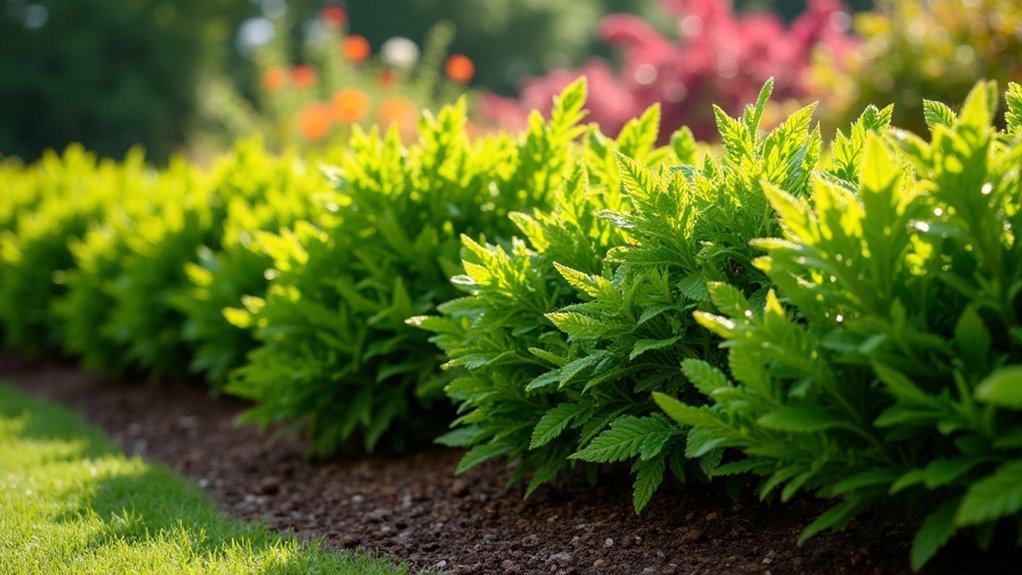
Since clay soil presents unique challenges throughout the year, maintaining your boundary hedges requires specific seasonal attention to guarantee they thrive.
In spring, fertilize clay soil hedges annually with balanced, slow-release fertilizer to boost growth as they emerge from dormancy. This is also the ideal time for pruning to maintain shape and stimulate healthy development.
Summer demands you water young clay soil hedges deeply during dry periods. Create watering basins around the base to direct moisture effectively to roots. Apply organic mulch to conserve moisture and gradually improve soil structure.
Fall is maintenance time—monitor for drainage issues before winter sets in, as waterlogged clay can cause root rot. Consider installing drainage solutions if you notice standing water.
Avoid heavy pruning to prevent stress before winter arrives.
Creating Wildlife-Friendly Boundaries With Clay-Loving Shrubs
While establishing attractive boundary hedges, you can simultaneously create thriving wildlife habitats by selecting the right clay-loving shrubs. Dogwood and Viburnum offer excellent wildlife cover, providing nesting sites and food sources through their berries and flowers.
Consider Pyracantha for your boundary—its dense growth creates protective barriers that deter predators while sheltering various bird species.
You’ll boost biodiversity by incorporating native options like Diervilla and Elderberry, which thrive in clay conditions while attracting essential pollinators.
For visual interest that still supports wildlife, add Rose of Sharon and Potentilla to your hedge design. Their summer blooms support pollinator populations throughout the growing season.
Solving Common Property Line Challenges With Strategic Shrub Selection
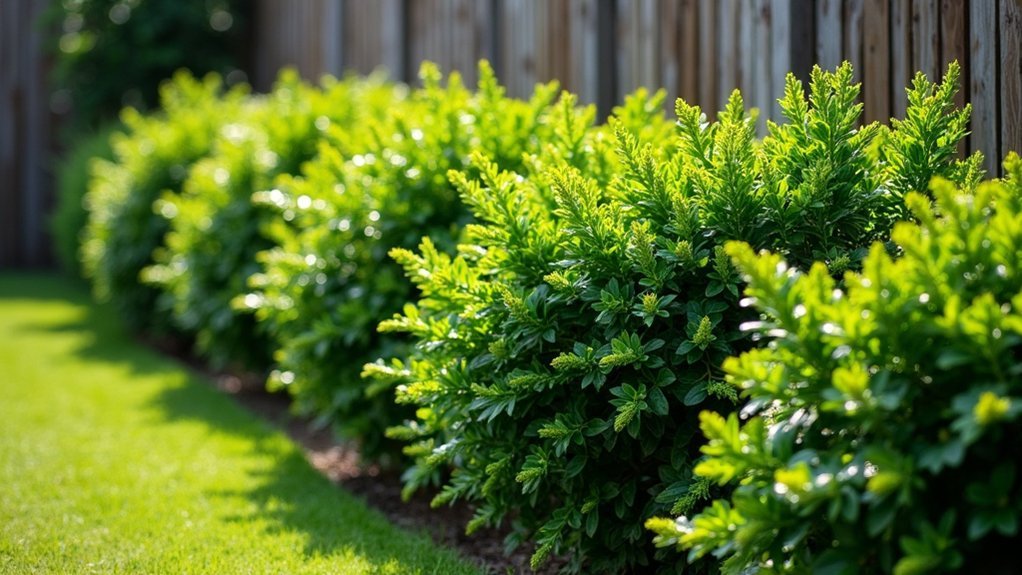
Property lines present unique landscaping challenges, from privacy concerns to soil variations and boundary disputes. Clay-loving shrubs offer strategic solutions for these common boundary hedge dilemmas while thriving in dense soils.
| Challenge | Recommended Shrub Solution |
|---|---|
| Privacy Issues | Viburnum or Dogwood (dense foliage) |
| Wildlife Damage | Elderberry or Weigela (pest resistant) |
| Seasonal Appeal | Rose of Sharon or Potentilla (extended blooming) |
| Poor Drainage | Aronia or Smooth Hydrangea (moisture tolerant) |
You’ll find drought-resistant varieties like certain Diervilla species particularly valuable when establishing boundary hedges in clay soil, as they prevent root rot while creating effective borders. Native selections adapt quickly to local conditions, requiring less maintenance while providing natural, defined boundaries that enhance property aesthetics and resolve demarcation questions.
Frequently Asked Questions
What Hedge Grows Best in Clay Soil?
You’ll find Viburnum tinus thrives in clay soil, creating a tough evergreen hedge. Don’t overlook Dogwood, Elderberry, and Pyracantha – they’re all fast-growing options that establish quickly in heavy clay conditions.
What Shrubs Grow Best in Heavy Clay Soil?
You’ll find that Dogwood, Viburnum, Diervilla, Elderberry, Potentilla, Smooth Hydrangea, Laurel, and Elaeagnus thrive in heavy clay soil. They’ll provide robust growth and vibrant foliage despite challenging soil conditions.
What Is the Best Ground Cover for Heavy Clay?
For heavy clay, you’ll find Low Scape Mound Aronia, Potentilla, Diervilla’s Kodiak series, Elderberry varieties, and Creeping Dogwood make excellent ground covers. They’re all low-maintenance options that thrive where other plants struggle.
What Are the Best Plants to Create a Boundary?
For your boundary, you’ll get excellent results with Dogwood, Elderberry, Viburnum, Diervilla, and Potentilla. They’re all clay-tolerant shrubs that’ll create attractive living screens while offering seasonal interest throughout the year.
In Summary
You’ll find success with clay soil boundary hedges by choosing the right shrubs for your specific conditions. Whether you’ve selected viburnum, ninebark, or aronia, remember that proper spacing and seasonal maintenance are key. Your new living border won’t just define your property—it’ll create habitat, solve drainage issues, and add year-round beauty that thrives where other plants struggle.


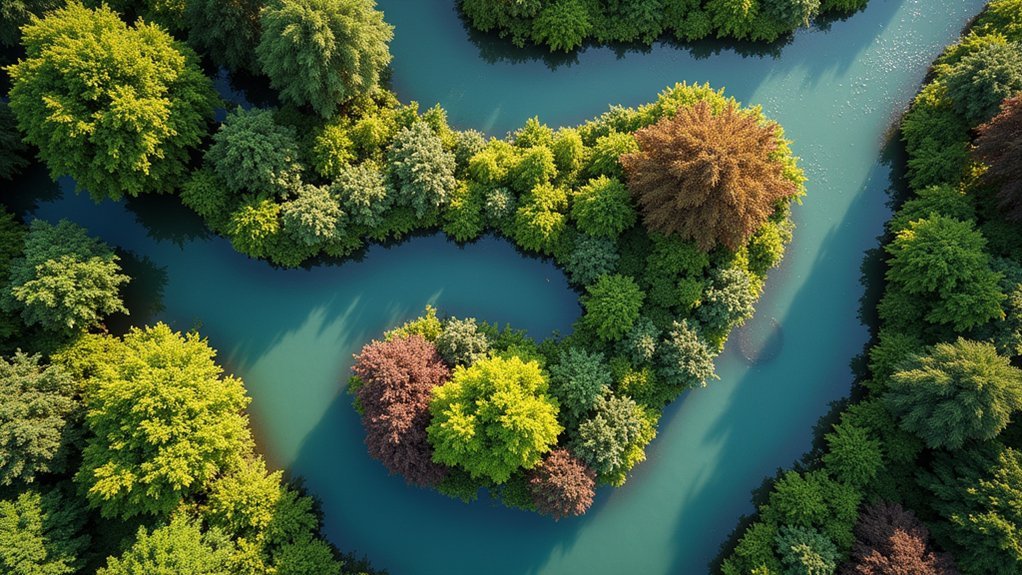
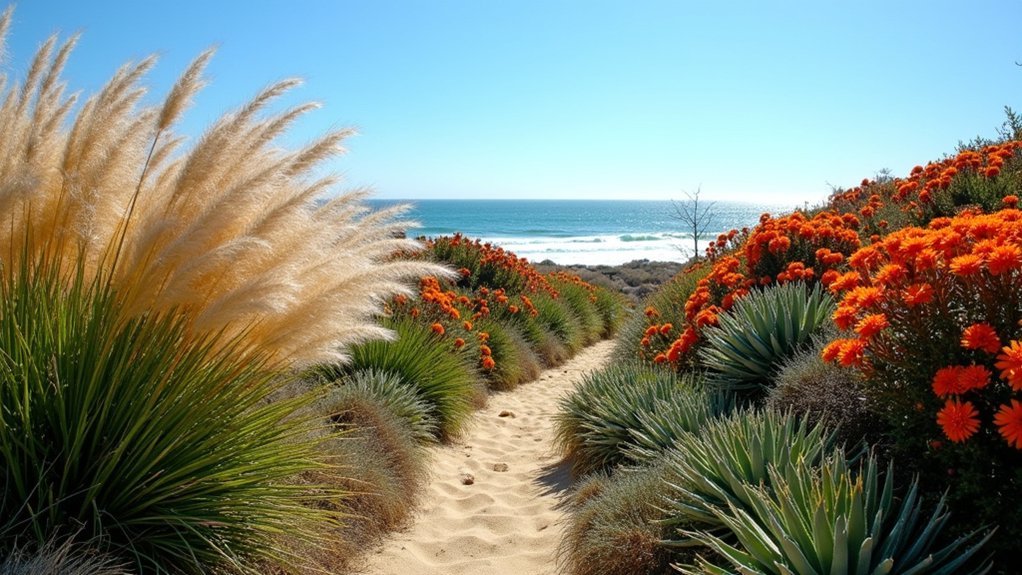
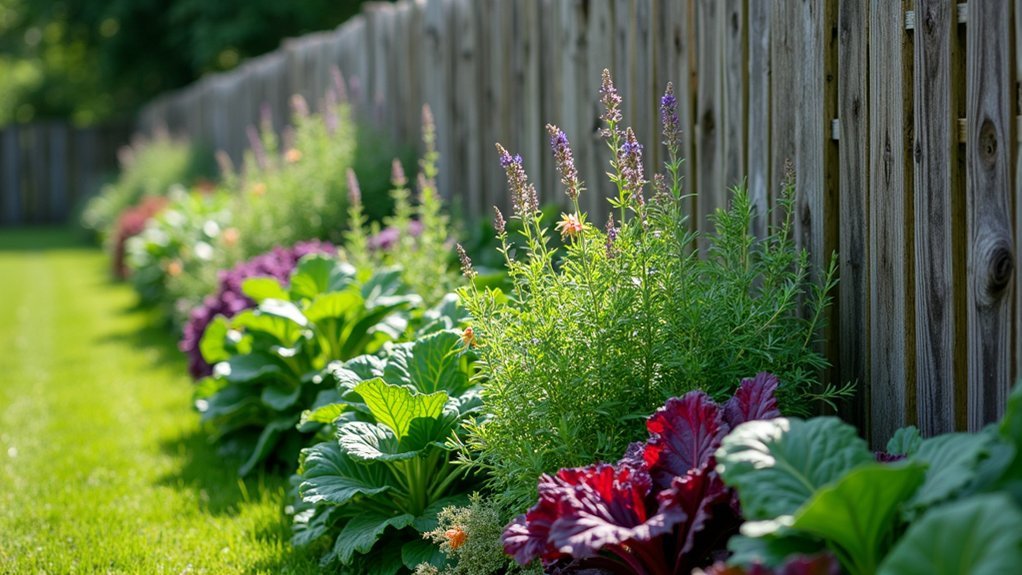
Leave a Reply